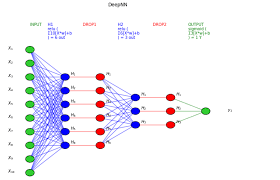
Introduction to the Course
This course offers a comprehensive introduction to the world of Neural Networks and Deep Learning, covering key concepts, algorithms, and techniques that power modern AI systems.
Who is this course for?
- Freshers with any Graduation degree
- Professionals who want to switch from NON-IT to IT
- Professionals who want to boost there career
Requirements
Before starting this course, it is recommended that you have basic knowledge of:
- Basic understanding of Python Programming Language
- Mathematics (especially algebra and statistics).
What You'll Learn
How Neural Networks Work and Backpropagation▶
- What can Deep Learning do?
- The Rise of Deep Learning.
- The Essence of Neural Networks.
- Working with different datatypes.
- The Perceptron.
- Gradient Descent.
- The Forward Propagation.
- Backpropagation.
Loss Functions▶
- Mean Squared Error (MSE).
- L1 Loss (MAE).
- Huber Loss.
- Binary Cross Entropy Loss.
- Cross Entropy Loss.
- Softmax Function.
- KL divergence Loss.
- Contrastive Loss.
- Hinge Loss.
- Triplet Ranking Loss.
Activation Functions▶
- Why we need activation functions.
- Sigmoid Activation.
- Tanh Activation.
- ReLU and PReLU.
- Exponentially Linear Units (ELU).
- Gated Linear Units (GLU).
- Swish Activation.
- Mish Activation.
Regularization and Normalization▶
- Overfitting.
- L1 and L2 Regularization.
- Dropout.
- DropConnect.
- Normalization.
- Batch Normalization.
- Layer Normalization.
- Group Normalization.
Optimization▶
- Batch Gradient Descent.
- Stochastic Gradient Descent.
- Mini-Batch Gradient Descent.
- Exponentially Weighted Average Intuition.
- Exponentially Weighted Average Implementation.
- Bias Correction in Exponentially Weighted Averages.
- Momentum.
- RMSProp.
- Adam Optimization.
- SWATS - Switching from Adam to SGD.
- Weight Decay.
- Decoupling Weight Decay.
- AMSGrad.
Hyperparameter Tuning and Learning Rate Scheduling▶
- Introduction to Hyperparameter Tuning and Learning Rate Recap.
- Step Learning Rate Decay.
- Cyclic Learning Rate.
- Cosine Annealing with Warm Restarts.
- Batch Size vs Learning Rate.
Introduction to PyTorch ▶
- Computation Graphs and Deep Learning Frameworks.
- Installing PyTorch and an Introduction.
- How PyTorch Works.
- Torch Tensors.
- Numpy Bridge, Tensor Concatenation and Adding Dimensions.
- Automatic Differentiation.
- Loss Functions in PyTorch.
- Weight Initialization in PyTorch.
- Data Preprocessing.
- Data Normalization.
- Creating and Loading the Dataset.
- Building the Network.
- Training the Network.
- Visualize Learning.
Data Augmentation▶
- 1_Introduction to Data Augmentation.
- 2_Data Augmentation Techniques Part 1 .
- 2_Data Augmentation Techniques Part 2 .
- 2_Data Augmentation Techniques Part 3.
Implementing to Neural Networks with Numpy▶
- The Dataset and Hyperparameters.
- Understanding the Implementation.
- Forward Propagation.
- Loss Function.
- Prediction.
- Notebook for the following Lecture.
- Backpropagation Equations.
- Backpropagation.
- Initializing the Network.
- Training the Model.
Convolutional Neural Networks (CNN)▶
- Prerequisite: Filters.
- Introduction to Convolutional Networks and the need for them.
- Filters and Features.
- Convolution over Volume Animation Resource.
- Convolution over Volume Animation.
- More on Convolutions.
- Test your Understanding.
- Quiz Solution Discussion.
- A Tool for Convolution Visualization.
- Activation, Pooling and FC.
- CNN Visualization.
- Important formulas.
- CNN Characteristics.
- Regularization and Batch Normalization in CNNs.
- DropBlock: Dropout in CNNs.
- Softmax with Temperature.
CNN Architectures▶
- CNN Architectures.
- Residual Networks.
- Stochastic Depth.
- Densely Connected Networks.
- Squeeze-Excite Networks.
- Seperable Convolutions.
- Transfer Learning.
- Is a 1x1 convolutional filter equivalent to a FC layer?.
Convolutional Networks Visualization▶
- Data and the Model.
- Processing the Model.
- Visualizing the Feature Maps.
YOLO Object Detection(Theory)▶
- YOLO Theory.
Autoencoders and Variational Autoencoders▶
- Autoencoders.
- Denoising Autoencoders.
- The Problem in Autoencoders.
- Variational Autoencoders.
- Probability Distributions Recap.
- Loss Function Derivation for VAE.
- Deep Fake.
Neural Style Transfer▶
- NST Theory.
Recurrent Neural Networks (RNN)▶
- Why do we need RNNs.
- Vanilla RNNs.
- Test your understanding.
- Quiz Solution Discussion.
- Backpropagation Through Time.
- Stacked RNNs.
- Vanishing and Exploding Gradient Problem.
- LSTMs.
- Bidirectional RNNs.
- GRUs.
- CNN-LSTM.
Word Embeddings▶
- What are Word Embeddings.
- Visualizing Word Embeddings.
- Measuring Word Embeddings.
- Word Embeddings Models.
- Word Embeddings in PyTorch.
Transformers▶
- SANITY CHECK ON PREVIOUS SECTIONS.
- Introduction to Transformers.
- Input Embeddings.
- Positional Encoding.
- MultiHead Attention.
- Concat and Linear.
- Residual Learning.
- Layer Normalization.
- Feed Forward.
- Masked MultiHead Attention.
- MultiHead Attention in Decoder.
- Cross Entropy Loss.
- KL Divergence Loss.
- Label Smoothing.
- Dropout.
- Learning Rate Warmup.
BERT▶
- What is BERT and its structure.
- Masked Language Modelling.
- Next Sentence Prediction.
- Fine-tuning BERT.
- Exploring Transformers.
Other Transforms▶
- Universal Transformers.
- Visual Transformers.
GPT (Generative Pre-trained Transformer)▶
- What is GPT.
- Zero-Shot Predictions with GPT.
- Byte-Pair Encoding.
- Technical Details of GPT.
- Playing with HuggingFace models.
- Implementation.
Trainer Expertise
This program is monitored by a team of professionals. We have crafted this program using the learnings of 23+ years of experience handling corporate training and job oriented training. Our students are working in almost all top MNCs across India.
Job Opportunities
100% placement record — each student successfully transitioned into a desired Machine Learning career role.
Course Duration
16 Weeks
Fees
Training + Job Assistance: ₹35,000
- Admission: ₹10,000
- After 1 month: ₹25,000

